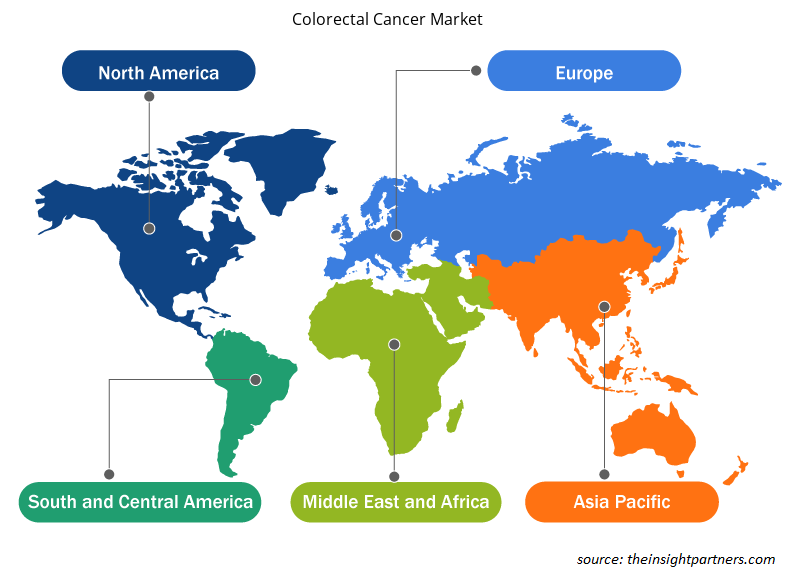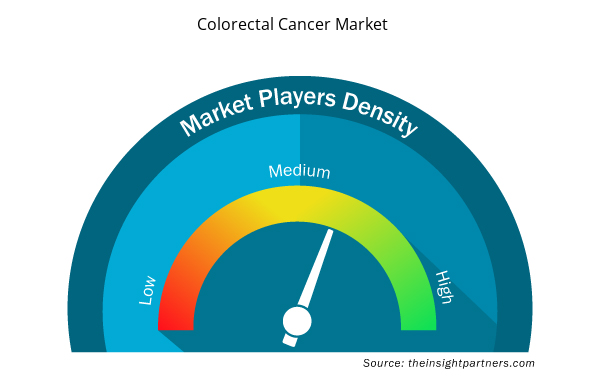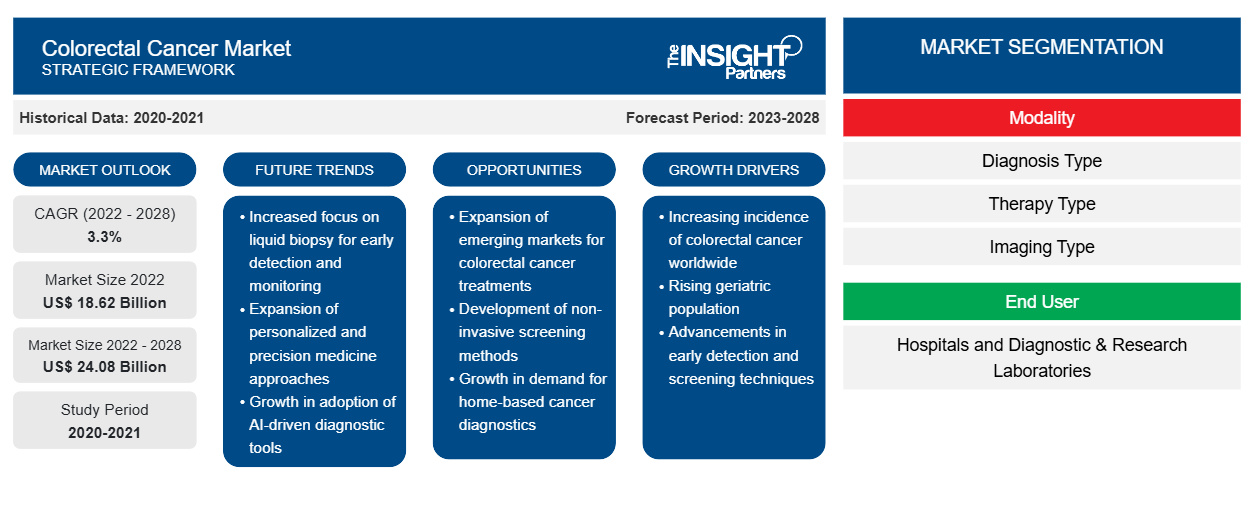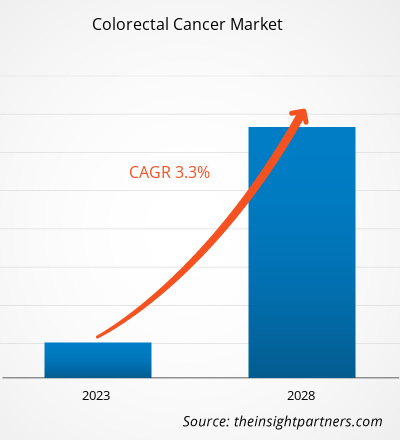Der Markt für Dickdarmkrebs soll von 18.619,3 Millionen US-Dollar im Jahr 2022 auf 24.078,5 Millionen US-Dollar im Jahr 2028 wachsen; von 2022 bis 2028 wird mit einer durchschnittlichen jährlichen Wachstumsrate von 3,3 % gerechnet.
Faktoren wie die zunehmende Verbreitung von Dickdarmkrebs , Produkteinführungen und Vorteile von Generika treiben das globale Wachstum des Dickdarmkrebsmarktes voran . Der Preisdruck auf die Arzneimittelhersteller bremst jedoch das Marktwachstum.
Kolorektaler Krebs ist ein bösartiger Tumor der Innenwand des Dickdarms. Er entsteht durch abnormales Zellwachstum, das in andere Körperteile eindringen oder sich dort ausbreiten kann. Kolorektaler Krebs wird häufig durch entzündliche Darmerkrankungen und genetische Veranlagung verursacht. Müdigkeit, Durchfall oder Verstopfung, Kurzatmigkeit, Schwäche, veränderte Stuhlgewohnheiten, rotes oder dunkles Blut im Stuhl, Gewichtsverlust, Bauchschmerzen und Blähungen sind einige der häufigsten Symptome. Kolorektaler Krebs wird in vier Stadien eingeteilt: Stadium 0, Stadium I – Krebs in den inneren Schichten des Dickdarms, Stadium II – Krebs breitet sich durch die Muskelwand des Dickdarms aus, Stadium III – Krebs breitet sich in die Lymphknoten aus und Stadium IV – Krebs breitet sich in andere Organe aus. Kolorektaler Krebs kann mit Chemotherapie, Strahlentherapie und Operation behandelt werden.
Passen Sie diesen Bericht Ihren Anforderungen an
Sie erhalten kostenlos individuelle Anpassungen an jedem Bericht, einschließlich Teilen dieses Berichts oder einer Analyse auf Länderebene, eines Excel-Datenpakets sowie tolle Angebote und Rabatte für Start-ups und Universitäten.
- Holen Sie sich die wichtigsten Markttrends aus diesem Bericht.Dieses KOSTENLOSE Beispiel umfasst eine Datenanalyse von Markttrends bis hin zu Schätzungen und Prognosen.
Nordamerika wird im Prognosezeitraum wahrscheinlich den Markt für Dickdarmkrebs dominieren , da die Zahl der Dickdarmkrebserkrankungen zunimmt , die Gesundheitsinfrastruktur besser ist, die Regierung eine unterstützende Politik betreibt, es eine große Anzahl multinationaler Unternehmen gibt und die Bevölkerung über diagnostische Tests und Geräte im Gesundheitswesen gut informiert ist. Darüber hinaus hatten die USA im Jahr 2022 den größten Anteil am nordamerikanischen Markt und es wird erwartet, dass das Land im Prognosezeitraum den regionalen Markt dominieren wird. Laut der American Cancer Society ist Dickdarmkrebs die dritthäufigste Krebserkrankung, die in den USA bei Männern und Frauen diagnostiziert wird. Im Jahr 2021 wurden im Land ~104.270 neue Fälle von Dickdarmkrebs und 45.230 neue Fälle von Mastdarmkrebs gemeldet. Das Lebenszeitrisiko, an Dickdarmkrebs zu erkranken, beträgt bei Männern ~1 zu 22, was ~5 % entspricht. Bei Frauen beträgt es etwa 1 zu 24, was ~4,5 % entspricht. Diese steigende Zahl von Krebsfällen erhöht die Nachfrage nach Behandlung und Diagnostik von Dickdarmkrebs im ganzen Land.
Der globale Markt für Dickdarmkrebs ist nach Modalität, Endnutzer und Geografie segmentiert. Geografisch ist der Markt in Nordamerika, Europa, Asien-Pazifik, den Nahen Osten und Afrika sowie Süd- und Mittelamerika segmentiert. Der globale Marktbericht für Dickdarmkrebs bietet Einblicke und eine eingehende Analyse des Marktes und betont Parameter wie Markttrends, technologische Fortschritte, Marktdynamik und die Wettbewerbsanalyse der weltweit führenden Marktteilnehmer.
Markteinblicke
Anstieg der Fälle von Dickdarmkrebs
Darmkrebs ist eine der am häufigsten auftretenden und tödlichsten Krebsarten, die bei Personen unter dem kombinierten Einfluss genetischer und umweltbedingter Faktoren entsteht. Laut der Weltgesundheitsorganisation (WHO) ist Darmkrebs die dritthäufigste Krebsart mit weltweit etwa 1,93 Millionen Fällen im Jahr 2020, und bis 2030 wird ein Anstieg der Darmkrebsfälle weltweit um etwa 70 % erwartet. Darüber hinaus macht Darmkrebs ( CRC ) laut dem National Institute of Health über 9 % aller Krebserkrankungen aus und war im Jahr 2020 weltweit eine der Hauptursachen für Morbidität und Mortalität. Außerdem variieren die Mortalitäts- und Inzidenzraten von Darmkrebs weltweit, und im Jahr 2020 waren etwa 916.000 Todesfälle auf Darmkrebs zurückzuführen . Es ist die dritthäufigste Krebsart bei Männern und die zweithäufigste Krebsart bei Frauen. Das Lebenszeitrisiko, an Darmkrebs zu erkranken , liegt bei Männern bei etwa 1 zu 23 und bei Frauen bei 1 zu 25. Aus diesen Gründen wurde Dickdarmkrebs als die dritthäufigste Krebsart und als die Krebsart mit der zweithöchsten Todesursache eingestuft.
Darmkrebs betrifft zunehmend die Bevölkerung in asiatischen Ländern. Laut der Internationalen Agentur für Krebsforschung und GLOBOCAN beispielsweise betrug die geschätzte Inzidenz von Darmkrebs in Asien im Jahr 2020 etwa 1.009.400 neue Fälle. Japan, China, Malaysia, Singapur, Korea und die Türkei verzeichneten im Vergleich zu den anderen Ländern im asiatisch-pazifischen Raum hohe Prävalenzraten.
Bei Menschen mit lokalisiertem Dickdarmkrebs liegt die Überlebenschance nach fünf Jahren bei 90 %. Die 5-Jahres-Überlebensrate beträgt 71 %, wenn sich der Krebs auf benachbarte Gewebe, Organe oder regionale Lymphknoten ausbreitet. Die häufigsten Behandlungsmethoden für Dickdarmkrebs sind Operation, Immuntherapie, Chemotherapie, Strahlentherapie und zielgerichtete Therapie. Je nach Krebsstadium können zwei oder mehr dieser Behandlungsmethoden gleichzeitig oder nacheinander angewendet werden.
Somit hat die steigende Zahl der an dieser Krankheit leidenden Patienten zu einer erhöhten Nachfrage nach Lösungen für Dickdarmkrebs geführt und damit das Wachstum des weltweiten Dickdarmkrebsmarktes vorangetrieben.
Modalitätseinblicke
Basierend auf der Modalität ist der globale Markt für Dickdarmkrebs in Diagnosetyp, Therapietyp und Bildgebungstyp segmentiert. Im Jahr 2022 hält das Segment Diagnosetyp den größten Marktanteil und wird im Prognosezeitraum voraussichtlich die höchste CAGR verzeichnen. Darüber hinaus wird das Segment Diagnosetyp weiter in Immunhistochemie, Stuhltest, flexible Sigmoidoskopie, Koloskopie , CEA-Test und andere unterteilt. Das Segment Stuhltest wird im Prognosezeitraum voraussichtlich die höchste CAGR auf dem Markt verzeichnen, da immer mehr Patienten diagnostische Tests durchführen lassen.
Regionale Einblicke in den Markt für Dickdarmkrebs
Die regionalen Trends und Faktoren, die den Markt für Dickdarmkrebs im Prognosezeitraum beeinflussen, wurden von den Analysten von Insight Partners ausführlich erläutert. In diesem Abschnitt werden auch die Marktsegmente und die Geografie für Dickdarmkrebs in Nordamerika, Europa, im asiatisch-pazifischen Raum, im Nahen Osten und Afrika sowie in Süd- und Mittelamerika erörtert.

- Erhalten Sie regionale Daten zum Markt für Dickdarmkrebs
Umfang des Marktberichts über Dickdarmkrebs
| Berichtsattribut | Details |
|---|---|
| Marktgröße im Jahr 2022 | 18,62 Milliarden US-Dollar |
| Marktgröße bis 2028 | 24,08 Milliarden US-Dollar |
| Globale CAGR (2022 - 2028) | 3,3 % |
| Historische Daten | 2020-2021 |
| Prognosezeitraum | 2023–2028 |
| Abgedeckte Segmente | Nach Modalität
|
| Abgedeckte Regionen und Länder | Nordamerika
|
| Marktführer und wichtige Unternehmensprofile |
|
Marktteilnehmerdichte: Der Einfluss auf die Geschäftsdynamik
Der Markt für Dickdarmkrebs wächst rasant, angetrieben durch die steigende Endverbrauchernachfrage aufgrund von Faktoren wie sich entwickelnden Verbraucherpräferenzen, technologischen Fortschritten und einem größeren Bewusstsein für die Vorteile des Produkts. Mit steigender Nachfrage erweitern Unternehmen ihr Angebot, entwickeln Innovationen, um die Bedürfnisse der Verbraucher zu erfüllen, und nutzen neue Trends, was das Marktwachstum weiter ankurbelt.
Die Marktteilnehmerdichte bezieht sich auf die Verteilung der Firmen oder Unternehmen, die in einem bestimmten Markt oder einer bestimmten Branche tätig sind. Sie gibt an, wie viele Wettbewerber (Marktteilnehmer) in einem bestimmten Marktraum im Verhältnis zu seiner Größe oder seinem gesamten Marktwert präsent sind.
Die wichtigsten auf dem Markt für Dickdarmkrebs tätigen Unternehmen sind:
- Amgen Inc.
- Bruker Corporation
- Epigenomics AG
- Klinische Genomik-Technologien Pty Ltd.
- VolitionRx Limited
Haftungsausschluss : Die oben aufgeführten Unternehmen sind nicht in einer bestimmten Reihenfolge aufgeführt.

- Überblick über die wichtigsten Akteure auf dem Markt für Dickdarmkrebs
Erkenntnisse für Endbenutzer
Basierend auf dem Endverbraucher ist der globale Markt für Dickdarmkrebs in Krankenhäuser sowie Diagnose- und Forschungslabore unterteilt. Im Jahr 2022 hält das Krankenhaussegment einen größeren Marktanteil und wird im Prognosezeitraum voraussichtlich eine höhere CAGR auf dem Markt verzeichnen. Krankenhäuser sind die größten Einrichtungen, die über alle Einrichtungen verfügen. Das Krankenhaus bietet Patienten mit verschiedenen Krankheiten und Störungen umfassende Gesundheits- und medizinische Dienstleistungen. Heutzutage bieten Krankenhäuser ihren Patienten bessere Leistungen. Es werden sehr viele Patienten für den Eingriff aufgenommen, während viele Patienten zur Diagnose ohne Termin kommen. Unter den aufgenommenen Patienten leiden die meisten bereits an einigen Störungen. Krankenhäuser tragen also einen erheblichen Marktanteil zum globalen Dickdarmkrebsmarkt bei und werden diesen Trend im Prognosezeitraum voraussichtlich fortsetzen.
Mehrere Notfall- und Behandlungszentren müssen eine Untersuchung der Organe, Gewebe und Funktionen des Körpers durchführen, die mithilfe von Magnetresonanztomographie, CT und Röntgen genau durchgeführt werden kann. Die meisten Operationen werden in Krankenhäusern durchgeführt, da dort eine kontinuierliche Patientenversorgung und -überwachung stattfindet. Da Krankenhäuser die wichtigsten Gesundheitszentren für die Bevölkerung sind, wird dies in den Prognosejahren wahrscheinlich das Wachstum des Endverbrauchersegments vorantreiben. Aufgrund aller oben genannten Faktoren wird der globale Markt für Dickdarmkrebs im Krankenhaussegment in den kommenden Jahren wahrscheinlich wachsen.
Produkteinführungen und Kooperationen sind bei den Akteuren auf dem globalen Markt für Dickdarmkrebs weit verbreitete Strategien, um ihre globale Präsenz und ihr Produktportfolio zu erweitern. Die Akteure konzentrieren sich auch auf die Partnerschaftsstrategie, um ihren Kundenstamm zu vergrößern und so ihren Markennamen weltweit zu behaupten. Sie zielen darauf ab, ihre Marktanteile durch die Entwicklung innovativer Produkte zu steigern. Nachfolgend sind einige der jüngsten wichtigen Marktentwicklungen aufgeführt:
- Im Mai 2022 brachte Bruker innovative konduktionsgekühlte Maxwell-Magnete mit 7 Tesla und 9,4 Tesla für sein marktführendes Portfolio an präklinischen Magnetresonanztomographie-Systemen (MRT) auf den Markt. Nach dem Erfolg des BioSpec Maxwell 3-Tesla-Modells macht die neue Reihe von Maxwell-Magneten mit 7 Tesla und 9,4 Tesla das Nachfüllen von flüssigem Helium oder Stickstoff überflüssig und bietet gleichzeitig hohe Feldempfindlichkeit und Auflösung für fortgeschrittene präklinische MRT- und PET/MR-Forschung.
- Im Januar 2022 schlossen Amgen und Generate Biomedicines eine Forschungskooperationsvereinbarung zur Erforschung und Entwicklung von Proteintherapeutika für fünf klinische Ziele in mehreren Therapiebereichen und Modalitäten. Die Zusammenarbeit wird die Arzneimittelentdeckungsbemühungen verstärken und neue Proteinsequenzen mit optimalen therapeutischen Eigenschaften hervorbringen.
F. Hoffmann-La Roche AG, Epigenomics AG, Novigenix SA, Abbott Laboratories, Amgen Inc., Volitionrx, EDP Biotech, Clinical Genomics Technologies Pvt Ltd, Bruker und Quest Diagnostics Incorporated bieten Produkte und Dienstleistungen auf dem Markt an.
- Historische Analyse (2 Jahre), Basisjahr, Prognose (7 Jahre) mit CAGR
- PEST- und SWOT-Analyse
- Marktgröße Wert/Volumen – Global, Regional, Land
- Branche und Wettbewerbsumfeld
- Excel-Datensatz



Report Coverage
Revenue forecast, Company Analysis, Industry landscape, Growth factors, and Trends

Segment Covered
This text is related
to segments covered.

Regional Scope
North America, Europe, Asia Pacific, Middle East & Africa, South & Central America

Country Scope
This text is related
to country scope.
Häufig gestellte Fragen
Asia Pacific is expected to be the fastest growing region in colorectal cancer market over the forecast period due to developing healthcare infrastructure, enormous population base, growing prevalence of colorectal cancer patients, increased knowledge of the disease, growing government efforts, and technological improvement in the sector.
North America accounts for the major market share of colorectal cancer market in 2022 due to the increasing prevalence of colorectal cancer cases in the region and increased awareness about the disease.
The colorectal cancer market is expected to be valued at US$ 24,078.5 million in 2028.
The colorectal cancer market is analyzed in the basis of modality and end user. Based on modality, the market is segmented into diagnosis type, therapy type, and imaging type. The diagnosis type segment held the largest share of the market. Moreover, the same segment is anticipated to register the highest CAGR in the forecast period.
The colorectal cancer market is estimated to be valued at US$ 18,619.3 million in 2022.
The market is estimated to grow at a CAGR of 3.3% during the forecast period.
The colorectal cancer market majorly consists of the players, such as Epigenomics AG, Novigenix SA, Clinical Genomics Technologies Pty Ltd., EDP Biotech Corporation, Volitionrx Limited, Abbott Laboratories, Amgen Inc., F. Hoffmann-La Roche AG, Bruker Corporation, Quest Diagnostics Incorporated among others.
The factors that are driving the growth of market are rising prevalence of colorectal cancer, new product launches, and benefits offered by generic drugs boost the market growth. However, pricing pressure on drug manufacturers is the major factor hindering the colorectal cancer market growth.
Colorectal cancer is also known as bowel cancer, colon cancer, or rectal cancer. This type of cancer is the second leading cause of death in women and third in men. Colorectal cancer may be benign, or non-cancerous, or malignant. The symptoms shown by the patients who have colon cancer include changes in bowel habits, diarrhea or constipation, blood in stools that make it look black. Colorectal cancer can be treated with chemotherapy, radiotherapy, and surgery.
Trends and growth analysis reports related to Life Sciences : READ MORE..
The List of Companies - Colorectal Cancer Market
- Amgen Inc.
- Bruker Corporation
- Epigenomics AG
- Clinical Genomics Technologies Pty Ltd.
- VolitionRx Limited
- Novigenix SA
- F. Hoffmann-La Roche AG
- Abbott
- EDP Biotech
- Quest Diagnostics
The Insight Partners performs research in 4 major stages: Data Collection & Secondary Research, Primary Research, Data Analysis and Data Triangulation & Final Review.
- Data Collection and Secondary Research:
As a market research and consulting firm operating from a decade, we have published and advised several client across the globe. First step for any study will start with an assessment of currently available data and insights from existing reports. Further, historical and current market information is collected from Investor Presentations, Annual Reports, SEC Filings, etc., and other information related to company’s performance and market positioning are gathered from Paid Databases (Factiva, Hoovers, and Reuters) and various other publications available in public domain.
Several associations trade associates, technical forums, institutes, societies and organization are accessed to gain technical as well as market related insights through their publications such as research papers, blogs and press releases related to the studies are referred to get cues about the market. Further, white papers, journals, magazines, and other news articles published in last 3 years are scrutinized and analyzed to understand the current market trends.
- Primary Research:
The primarily interview analysis comprise of data obtained from industry participants interview and answers to survey questions gathered by in-house primary team.
For primary research, interviews are conducted with industry experts/CEOs/Marketing Managers/VPs/Subject Matter Experts from both demand and supply side to get a 360-degree view of the market. The primary team conducts several interviews based on the complexity of the markets to understand the various market trends and dynamics which makes research more credible and precise.
A typical research interview fulfils the following functions:
- Provides first-hand information on the market size, market trends, growth trends, competitive landscape, and outlook
- Validates and strengthens in-house secondary research findings
- Develops the analysis team’s expertise and market understanding
Primary research involves email interactions and telephone interviews for each market, category, segment, and sub-segment across geographies. The participants who typically take part in such a process include, but are not limited to:
- Industry participants: VPs, business development managers, market intelligence managers and national sales managers
- Outside experts: Valuation experts, research analysts and key opinion leaders specializing in the electronics and semiconductor industry.
Below is the breakup of our primary respondents by company, designation, and region:

Once we receive the confirmation from primary research sources or primary respondents, we finalize the base year market estimation and forecast the data as per the macroeconomic and microeconomic factors assessed during data collection.
- Data Analysis:
Once data is validated through both secondary as well as primary respondents, we finalize the market estimations by hypothesis formulation and factor analysis at regional and country level.
- Macro-Economic Factor Analysis:
We analyse macroeconomic indicators such the gross domestic product (GDP), increase in the demand for goods and services across industries, technological advancement, regional economic growth, governmental policies, the influence of COVID-19, PEST analysis, and other aspects. This analysis aids in setting benchmarks for various nations/regions and approximating market splits. Additionally, the general trend of the aforementioned components aid in determining the market's development possibilities.
- Country Level Data:
Various factors that are especially aligned to the country are taken into account to determine the market size for a certain area and country, including the presence of vendors, such as headquarters and offices, the country's GDP, demand patterns, and industry growth. To comprehend the market dynamics for the nation, a number of growth variables, inhibitors, application areas, and current market trends are researched. The aforementioned elements aid in determining the country's overall market's growth potential.
- Company Profile:
The “Table of Contents” is formulated by listing and analyzing more than 25 - 30 companies operating in the market ecosystem across geographies. However, we profile only 10 companies as a standard practice in our syndicate reports. These 10 companies comprise leading, emerging, and regional players. Nonetheless, our analysis is not restricted to the 10 listed companies, we also analyze other companies present in the market to develop a holistic view and understand the prevailing trends. The “Company Profiles” section in the report covers key facts, business description, products & services, financial information, SWOT analysis, and key developments. The financial information presented is extracted from the annual reports and official documents of the publicly listed companies. Upon collecting the information for the sections of respective companies, we verify them via various primary sources and then compile the data in respective company profiles. The company level information helps us in deriving the base number as well as in forecasting the market size.
- Developing Base Number:
Aggregation of sales statistics (2020-2022) and macro-economic factor, and other secondary and primary research insights are utilized to arrive at base number and related market shares for 2022. The data gaps are identified in this step and relevant market data is analyzed, collected from paid primary interviews or databases. On finalizing the base year market size, forecasts are developed on the basis of macro-economic, industry and market growth factors and company level analysis.
- Data Triangulation and Final Review:
The market findings and base year market size calculations are validated from supply as well as demand side. Demand side validations are based on macro-economic factor analysis and benchmarks for respective regions and countries. In case of supply side validations, revenues of major companies are estimated (in case not available) based on industry benchmark, approximate number of employees, product portfolio, and primary interviews revenues are gathered. Further revenue from target product/service segment is assessed to avoid overshooting of market statistics. In case of heavy deviations between supply and demand side values, all thes steps are repeated to achieve synchronization.
We follow an iterative model, wherein we share our research findings with Subject Matter Experts (SME’s) and Key Opinion Leaders (KOLs) until consensus view of the market is not formulated – this model negates any drastic deviation in the opinions of experts. Only validated and universally acceptable research findings are quoted in our reports.
We have important check points that we use to validate our research findings – which we call – data triangulation, where we validate the information, we generate from secondary sources with primary interviews and then we re-validate with our internal data bases and Subject matter experts. This comprehensive model enables us to deliver high quality, reliable data in shortest possible time.


 Holen Sie sich ein kostenloses Muster für diesen Bericht
Holen Sie sich ein kostenloses Muster für diesen Bericht